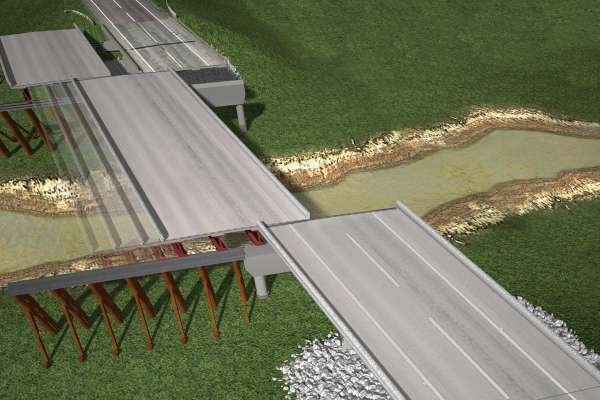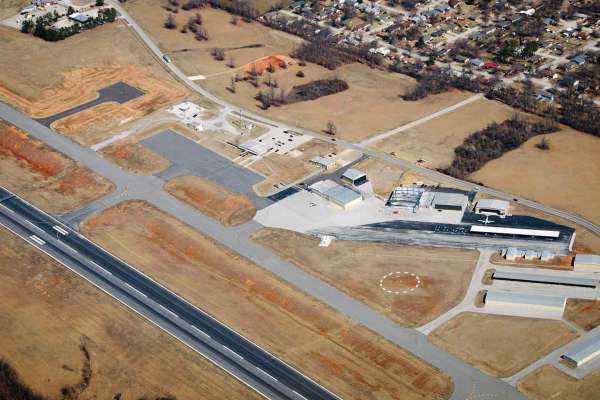An inside look at designing for Accelerated Bridge Construction
An innovative bridge construction method is being used for the first time in Oklahoma, and it looks to save motorists both time and money.
Accelerated Bridge Construction (ABC) methodology seeks to reduce construction duration and impacts on traffic. Additional benefits include improving work zone safety, eliminating temporary roadway construction, decreasing post-construction repairs to detour routes and reducing user costs. As bridge repair and replacement becomes increasingly more important throughout the nation, transportation officials are looking to utilize ABC methods.
"In 2010, it was estimated that 40 percent of bridges in the U.S. are at least 40 years old," said Garver Bridge Team Leader Jason Langhammer, PE. "With a bridge design life of 50 to 75 years, many of these aging bridges need to be replaced in the near future. Accelerated Bridge Construction expedites project delivery and lessens impacts to commuters, which is especially important in urban areas as well as rural locations that require long detours."
To meet the demand for maintaining our nation's aging infrastructure, the Federal Highway Administration has implemented the Every Day Counts program. This program encourages the use of innovative technologies to shorten project delivery, enhance highway safety and mitigate environmental impacts. The broad-based initiative covers many topics, including ABC.
The Oklahoma Department of Transportation (ODOT) recognizes the benefit of ABC and selected Garver to provide preliminary engineering and final design services to replace the State Highway 51 bridge over Cottonwood Creek in Creek County, Okla. This project was selected as a pilot project to evaluate the benefits of ABC techniques, and the knowledge gained can then be applied to other projects where ABC techniques are feasible and prudent.
There are several options to consider when constructing a bridge in an expedited manner. During the Cottonwood Creek bridge project's preliminary engineering phase, Garver investigated several ABC techniques, including pre-fabricated bridge elements and various structural placement methods. Site topography, hydraulic adequacy, site accessibility, existing facility geometry, user costs and total construction costs were also considered.
After evaluating all factors, a transverse sliding/skidding bridge move was selected. Using this method, the new superstructure is constructed on temporary supports adjacent to the existing structure. A track system and rollers are then used to move the bridge into position on top of new piers and abutments. This allows the existing bridge to stay in service while the new bridge is constructed, lessening the impacts to motorists.
When comparing the transverse sliding/skidding technique to conventional construction methods, it's estimated that the time needed to close and detour State Highway 51 can be conservatively reduced by five months. Because the detour is roughly 30 miles, this will save motorists thousands of miles in fuel costs and hours of drive time around the construction project.
"Considering the expenses attributed to user delay and fuel costs, it's estimated that motorists and the state's economy will save approximately $2 million," said Langhammer.
Two Bridges, Same Alignment
The Cottonwood Creek bridge was built in 1961 and is functionally obsolete. ODOT selected this site to consider ABC because of the deteriorating bridge's site accessibility. To construct the new bridge on the existing alignment, the contractor will first construct the substructure elements under the existing bridge—while it remains in service.
The proposed bridge's clear roadway width is 12 feet wider than the existing 28-foot-wide bridge, and the spans will change from six 45-foot-long steel spans to three Bulb-T prestressed concrete spans (two 70-foot end spans and one 120-foot center span). The proposed span configuration eliminates potential geometric conflicts between the existing and proposed structures and allows work outside of the Cottonwood Creek channel. The Bulb-T prestressed concrete beams have a larger structural depth than the existing superstructure, which allows the proposed substructure to be constructed below the existing in-service bridge.
"By using a deeper structural depth, we can lower the proposed bridge's bearing elevations and build piers and abutments beneath the existing bridge while it remains in service and still maintain hydraulic adequacy," Langhammer said.
Placing new piers underneath the existing bridge also proved a challenge. Drilled shaft foundations are typically used in Oklahoma, but the equipment used for shaft construction cannot fit under the existing bridge. For this reason, the drilled shafts are designed outside of the existing bridge's footprint, and long-span pier caps will be utilized. Using long-span pier caps in the traditional rectangular configuration are not the most structurally efficient; therefore a T-Beam configuration will be utilized to increase capacity and structural efficiency.
"By using a T-beam type of design, we are able to save about $50,000 in total construction costs," Langhammer said.
At the bridge's ends, driven piling would typically be utilized to resist dead, live, earth pressure, braking and wind loads. Again, equipment used in piling installation will not fit under the existing bridge. This resulted in positioning the new abutments in front of the existing ones, allowing for their construction while the existing bridge is in service. This configuration required specific design strategies related to lateral earth pressure. Similar to the piers, drilled shaft foundations will be constructed outside of the existing bridge's footprint. For this configuration, lateral earth pressures and the potential for excessive lateral deflections had to be accounted for. To reduce the earth pressures and assist in constructability, a soil nail wall will be utilized at abutment locations.
Transverse Slide
Due to tall embankments around the creek crossing as well as limited space for transport equipment, the transverse sliding method is best suited for the site.
"The transverse sliding/skidding system is often utilized for structures over rivers where adjacent construction will not impact traffic and where it's not viable to transport in prefabricated pieces," said Langhammer.
Building the bridge will occur in two phases. The first phase involves constructing the substructure elements under the existing bridge and the superstructure on temporary supports adjacent to the existing bridge. Once complete, the second phase requires closing and detouring traffic on State Highway 51, removing the old bridge, sliding the new bridge spans onto the support structures, and performing the final bridge and pavement connections.
"Once the substructure is constructed under the bridge and temporary structures are built outside the bridge, the contractor will build the new bridge on the temporary supports and lay the tracks and rollers for the slide," Langhammer said. "After the detour is installed and the existing bridge is demolished, they'll slide the new bridge into place. There are rollers underneath each span that run along the special track system, and the bridge will be pulled with hydraulic jacks. Essentially, this concept can be thought of as a drawer slide."
After the new spans are in place, the roadway approach pavements will be completed. "In less than three weeks of closure time, normal traffic operations should resume," Langhammer said.
Benefits of Accelerated Bridge Construction
- Work zone safety is improved. By reducing on-site construction time, the risk of conflict between motorists and construction crews is lessened.
- Temporary structures and shoo-fly detours can sometimes be eliminated. Using Accelerated Bridge Construction along with short-term detours instead of temporary structures and shoo-fly detours will often result in a net project cost savings.
- Post-construction repairs to detour routes are decreased. Conventional bridge construction often requires detour routes to handle higher volumes of traffic, and the loads placed on these roads for extended periods of time may lead to additional pavement repairs.
- User costs are reduced. Detours that are used for long periods can significantly increase costs on urban freeways and in rural locations. Using Accelerated Bridge Construction techniques provide a way to mitigate these costs.






Share this article